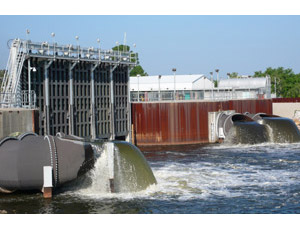The New Orleans District of the U.S. Army Corps of Engineers is gearing up for the June 1 start of hurricane season with tests of communications procedures, emergency management and equipment operation, says Heath Jones, a Corps emergency management specialist.

Nearly five years after Hurricane Katrina brought widespread devastation to New Orleans, the city is better protected against potential storm surge than it has ever been, officials say.
“The area has the best protection in its history and significantly more protection than it did last hurricane season,” says Karen Durham-Aguilera, director of the Corps Task Force Hope, which oversees the Corps’ $14.6-billion mission to bring southeast Louisiana to 100-year levels of protection by June 2011.
The Corps conducted a hurricane simulation exercise May 10-14 with participation from New Orleans area district commanders and Gen. Michael Walsh, commander of the Mississippi Valley Division in Vicksburg, Miss. “We had our National Weather Service forecaster come up with a fake storm, Hurricane Gertrude, for a top-level exercise where we ran a sequence with a hurricane coming at us from seven days out,” Jones says.
On May 27 the Corps focused on a physical exercise of equipment, including the closing of surge barrier gates at the city’s three outfall canals and cranking up the discharge pumps. All of the gates were lowered and pumps were operated to the maximum capacity that water flow allowed.
“When we do the regular, monthly tests, we run the pumps by shore power, but this year did a test with backup generator power,” Jones says. The Corps also practiced operating the pumps remotely from the bunker at the NOD headquarters by using a system control and data acquisition (SCADA) system. “We can run everything we need to do at the outfall canals from this building in case the safe houses (where pump operators are stationed) are evacuated during an event,” Jones says.
The SCADA system has been in place for about three years. The Corps also has implemented several redundant communications systems that weren’t in place during Hurricane Katrina. “We have a statewide radio system, satellite phones and portable satellite [modems] for network connections,” Jones says.
It’s procedure for the Corps to deploy hurricane personnel teams for remote operations to its Vicksburg District and a rear emergency operations center at Port Allen, outside of the state capital. During the past couple of weeks, the Corps has deployed teams to those locations to check procedure and communications equipment.
During a hurricane event, the Corps also embeds liaisons with representatives of 13 parishes, the Governor’s Office of Homeland Security and Emergency Preparedness and the Southeast Louisiana Flood Protection Authorities east and west, “for information exchange, to keep clear lines of communication,” Jones say. “If any requests come up for assistance, we are there right away.”
The organizational drills and testing build upon physical improvements that also have been made in the last year to much of the 350-mile system of levees, floodwalls and pump stations that protect the city. Chief among the new features is the $1.3-billion Lake Borgne Inner Harbor Navigation Canal Storm Surge Barrier, which is nearing completion.
The 1.8-mile long structure – which includes a central, concrete reinforced barrier wall, three navigational gates and tie-ins to concrete T-walls–is designed to block storm surge from Lake Borgne and the Gulf of Mexico beyond at a critical juncture on the city’s eastern side.
Corps prime contractor Shaw Environmental & Infrastructure plans to deliver more than 90% of the 100-year levels of protection by July. Although hurricane season officially runs from June 1 to November 30, the most active part of the season for New Orleans is usually in July and August.
“The entire barrier wall, barge gate and tie-ins will be at the 100-year elevation by the height of hurricane season,” says Nancy Allen, public affairs officer for the Corps’ Hurricane Protection Office.
Cofferdams will be in place at two locations in the barrier, leaving gaps in the 100-year protection until work is complete June 2011. “It is difficult to quantify what level of protection the barrier will provide before it is complete,” Allen says. “[But] We are better off than we were last hurricane season.”
The Corps has awarded 255 of the anticipated 360 construction contracts it expects to award to finish bringing the hurricane defense system to where it can protect against a storm that has a 1% chance of occurring in any year by 2011, Durham-Aguilera says.

Post a comment to this article
Report Abusive Comment